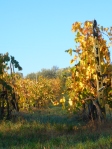 Fall in Tuscany can be magical. The swarming crowds of tourists are gone, leaving the lines for museums and restaurants tolerable. The heat and humidity have abated too, and a drive through through Tuscany’s wine zones reveals rolling hills draped in the bright fall call colors of the turning grape vines. And, as always in Italy, there are edible treats to discover…
Fall in Tuscany can be magical. The swarming crowds of tourists are gone, leaving the lines for museums and restaurants tolerable. The heat and humidity have abated too, and a drive through through Tuscany’s wine zones reveals rolling hills draped in the bright fall call colors of the turning grape vines. And, as always in Italy, there are edible treats to discover…
Vino Nuovo – Young Wine
Fall is the harvest season. Grapes are typically ready for harvesting early in the season, which is the period in which you’ll find most of the harvest festivals. Vino nuovo has a delicate, grape flavour that is lost when wine is matured. It is the perfect pair to a spuntino or snack of roasted chestnuts.
Olio Nuovo – Freshly Pressed Olive Oil
Harvested throughout the season another one of Tuscany’s great fall treasures is freshly pressed olive oil, or olio nuovo. Generally olives harvested earlier in the season produce oils with a variety of distinct flavors which vary from region to region, while olives harvested later in the season produce oils with more mellow flavors. Regardless of the harvest period, olio nuovo has some special characteristics. For one, olio nuovo is cloudier than matured oil, and that of Tuscany classically has a rich green color. Olio nuovo also has special taste characteristics – its flavor is more pungent and rich than the older, matured oil found in supermarkets and out of season, and it is also piccicoso – a good gulp of the rich liquid tickles the back of the throat. To fully enjoy the flavors of olio nuovo we recommend using it in simple dishes (such as poured over a piece of good, toasted bread, or drizzled over fish, beans, vegetables, or a simple soup), and using it with minimal heating, as the taste characteristics quickly cook out.
Unfortunately for frantoii, or olive pressers, and gourmands, this year’s olive harvest here in Tuscany was rather meager due to an unusually dry summer and a difficult battle with fruit flies. But there is still olio nuovo to be had. Plenty of oil producers participate in the farmer’s markets, or fiere, found in the piazzas across Florence on the weekends, and specialty shops in Florence sell it as well, though at an inflated price. You can buy olio nuovo directly from a number of oil-producing villas, too, which can be a great excuse for escaping the city to drive through scenic areas like Chianti and Impruneta.
Castagne e Marroni – Chestnuts
The last great treasure of fall in Tuscany is the fabulous chestnuts. Chestnuts are found in two varieties: castagne, which are typically a lighter brown color and heart-shaped with a flat back and rounded belly, and marroni, which are typically darker brown, larger than castagne, and more spherical. This year an invasive worm took care of most of Tuscany’s castagne, but the marroni harvest was generous enough. Chestnuts of both varieties can be roasted, boiled, or ground into flour to be used in a variety of sweets. Roasted chestnuts, or caldarroste, can be bought piping hot from street vendors, or you can buy (for much cheaper) a bag of raw chestnuts and roast them yourself over a fire in a wide pan with holes punched in the bottom. Chestnuts can also be boiled, though they lose a great deal of their delicate flavour. This treatment, though, is perfect if you want to add the chestnuts as part of complicated dish. Lastly, chestnuts are also ground into chestnut flour, or farina di castagne, to be used for a variety of sweets and desserts. One of our favorites is castagnaccio. Castagnaccio is made by baking a batter of chestnut flour, oil, and water (some also add sugar and/or milk), and is often decorated with rosemary, golden raisins, and pignoli nuts or walnuts. It has the consistency of fudge, but is only slightly sweet, with a delicate, nutty flavour. Castagnaccio can be found in bakeries (forni) and markets throughout Tuscany.



